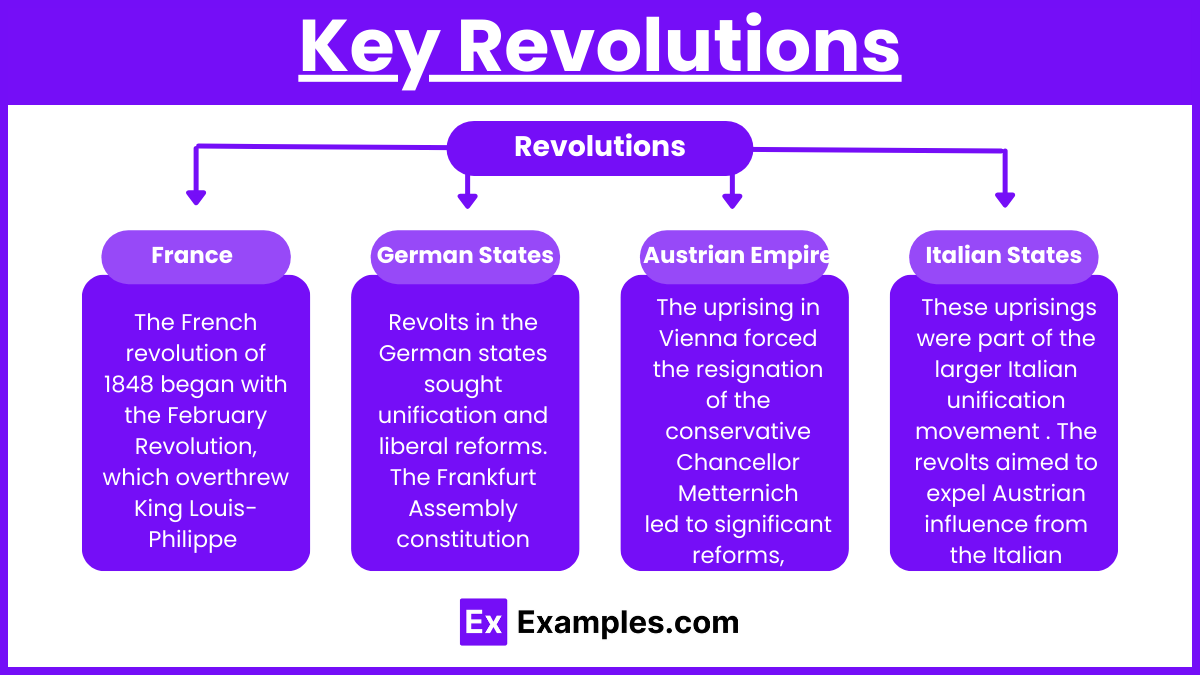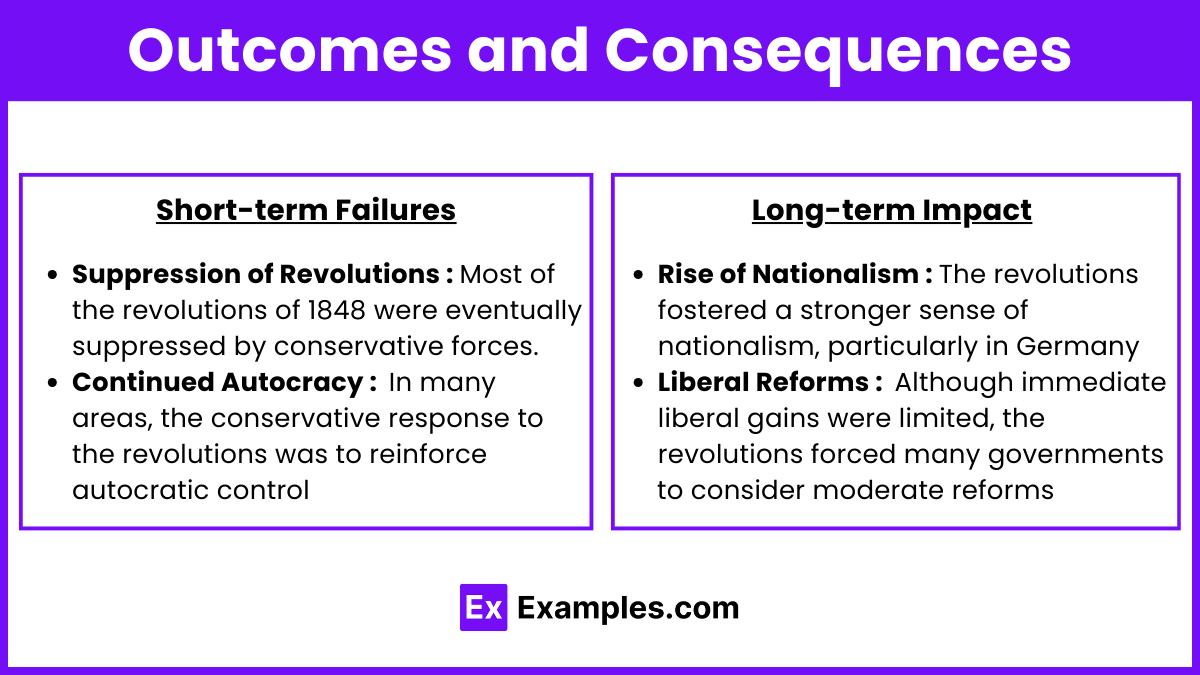The Revolutions of 1848, known as the Springtime of Nations, were a series of interconnected political upheavals across Europe, a key topic in AP European History. Sparked by widespread discontent with autocratic regimes, economic hardships, and nationalist aspirations, these revolutions sought liberal reforms and greater political representation. Though most uprisings were swiftly suppressed, they marked a significant turning point, highlighting the growing influence of liberalism, socialism, and nationalism. The revolutions’ legacy persisted, ultimately shaping the political landscape of Europe in the years to come.
Learning Objectives
By studying the Revolutions of 1848 for the AP European History exam, you should understand the social, economic, and political causes behind these widespread uprisings. Analyze key events and outcomes in countries like France, the German states, Austria, and Italy. Evaluate the short-term failures and long-term impacts on nationalism, liberal reforms, and political ideologies. Recognize the role of significant figures and how these revolutions influenced the development of modern Europe. This knowledge will help you grasp the broader context of 19th-century European history.
Causes of the Revolutions

The causes of the Revolutions of 1848 include widespread dissatisfaction with autocratic governments, economic hardships due to industrialization and poor harvests, and rising nationalist sentiments seeking independence and political reforms across Europe, aiming for greater freedoms and representation.
Social and Economic Discontent
- Industrialization and Urbanization: The Industrial Revolution had transformed the European economy, leading to significant urban growth. However, this rapid industrialization also resulted in poor working conditions, low wages, and a growing disparity between the wealthy and the working classes.
- Agricultural Crises: A series of poor harvests in the 1840s, particularly the Irish Potato Famine, caused widespread famine and economic hardship, exacerbating social tensions.
- Rise of the Middle Class: The burgeoning middle class, consisting of merchants, professionals, and business owners, sought greater political power and representation, challenging the traditional aristocratic order.
Political Factors
- Autocratic Governments: Many European countries were still under autocratic rule, with limited political freedoms and representation. This led to widespread demands for liberal reforms, including constitutional governments and expanded suffrage.
- Nationalism: Nationalist movements gained momentum, particularly in multi-ethnic empires like Austria and the German states. Various ethnic groups sought independence or greater autonomy.
Key Revolutions

France
- February Revolution: The French revolution of 1848 began with the February Revolution, which overthrew King Louis-Philippe and led to the establishment of the Second Republic.
- June Days: This period of social and economic unrest followed, driven by the closure of national workshops, which had provided employment for many urban workers.
German States
- March Revolution: Revolts in the German states sought unification and liberal reforms. The Frankfurt Assembly was convened to draft a constitution for a unified Germany, though it ultimately failed due to internal divisions and lack of support from Prussian and Austrian monarchies.
Austrian Empire
- Vienna Uprising: The uprising in Vienna forced the resignation of the conservative Chancellor Metternich and led to significant reforms, including the abolition of serfdom.
- Hungarian Revolution: Led by Lajos Kossuth, Hungary sought greater autonomy, ultimately declaring independence from Austria. The movement was suppressed with Russian assistance.
Italian States
- Revolts in Milan and Venice: These uprisings were part of the larger Italian unification movement (Risorgimento). The revolts aimed to expel Austrian influence from the Italian peninsula and establish a unified Italian state.
Outcomes and Consequences

Short-term Failures
- Suppression of Revolutions: Most of the revolutions of 1848 were eventually suppressed by conservative forces. Monarchies retained power, and many liberal reforms were reversed.
- Continued Autocracy: In many areas, the conservative response to the revolutions was to reinforce autocratic control and clamp down on political dissent.
Long-term Impact
- Rise of Nationalism: The revolutions fostered a stronger sense of nationalism, particularly in Germany and Italy, laying the groundwork for future unification efforts.
- Liberal Reforms: Although immediate liberal gains were limited, the revolutions forced many governments to consider moderate reforms to appease growing discontent. Over time, this led to the gradual expansion of political rights and the establishment of constitutional monarchies in some areas.
Significance in European History
The Revolutions of 1848 were pivotal in shaping modern European politics and society. They highlighted the growing tensions between the old order and emerging forces of change, such as liberalism, nationalism, and socialism. Although the immediate goals of the revolutionaries were often not realized, the revolutions set the stage for subsequent political developments and the eventual unification of Germany and Italy.
Key Figures
- Karl Marx and Friedrich Engels: Authors of “The Communist Manifesto,” which was published in the same year and influenced socialist and communist movements.
- Louis-Napoleon Bonaparte: Elected as the first President of France’s Second Republic, later became Emperor Napoleon III.
- Lajos Kossuth: A leader of the Hungarian Revolution, symbolizing the fight for national independence.
Examples
Example 1
The French Revolution of 1848
- Summary: This revolution led to the overthrow of King Louis-Philippe and the establishment of the Second French Republic. It was driven by economic hardship, social inequality, and demands for political reform.
- Key Events: February Revolution, Provisional Government formation, June Days Uprising.
- Outcome: Establishment of the Second Republic and the eventual rise of Louis-Napoleon Bonaparte.
Example 2
The German States Revolution of 1848
- Summary: A series of protests and uprisings across various German states aimed at unifying Germany and establishing liberal constitutions.
- Key Events: Frankfurt Assembly, March Revolutions, Heidelberg Assembly.
- Outcome: Failure to achieve unification or significant constitutional reforms, leading to the restoration of conservative regimes.
Example 3
The Austrian Empire Revolution of 1848
- Summary: Revolts in the Austrian Empire, including Vienna, Hungary, and other territories, demanding independence, constitutional government, and social reforms.
- Key Events: Vienna Uprising, Hungarian Revolution, Italian uprisings.
- Outcome: Temporary successes, but ultimately crushed by military force, leading to a reassertion of Habsburg authority.
Example 4
The Italian States Revolution of 1848
- Summary: Uprisings in various Italian states, including Sicily, Lombardy, and Venetia, aimed at expelling Austrian influence and achieving national unification.
- Key Events: Five Days of Milan, Siege of Venice, Roman Republic establishment.
- Outcome: Initial successes followed by military defeats and the restoration of Austrian control.
Example 5
The Hungarian Revolution of 1848
- Summary: A major national uprising within the Austrian Empire, led by Lajos Kossuth, seeking Hungarian independence and liberal reforms.
- Key Events: Declaration of independence, Battle of Pákozd, Austrian and Russian intervention.
- Outcome: Initial victories, but eventually suppressed by combined Austrian and Russian forces, leading to the re-establishment of Habsburg rule.
MCQs
Question 1
Which of the following was a common cause of the Revolutions of 1848 across Europe?
A) The rise of industrialization
B) The demand for universal suffrage
C) The decline of feudalism
D) The expansion of colonial empires
Answer: B) The demand for universal suffrage
Explanation:
The Revolutions of 1848, also known as the “Springtime of Nations,” were a series of political upheavals throughout Europe. A common thread among these revolutions was the demand for more democratic governance, including universal suffrage. Many people across Europe sought greater political representation and the ability to participate in government. This movement was driven by widespread discontent with authoritarian rule, economic hardships, and a desire for more liberal political systems.
Question 2
Which country did NOT experience a revolution in 1848?
A) France
B) Russia
C) Germany
D) Italy
Answer: B) Russia
Explanation:
While many European countries experienced revolutions in 1848, Russia did not. The Tsarist regime in Russia maintained strict control over political dissent, and the country did not see a major revolutionary movement during this period. However, revolutionary ideas did spread to Russia, influencing future events like the 1905 and 1917 revolutions. In contrast, countries like France, Germany, and Italy saw significant uprisings during 1848, driven by a mix of political, social, and economic grievances.
Question 3
What was the outcome of the Revolutions of 1848 in most European countries?
A) Permanent establishment of democratic governments
B) Immediate success in achieving all revolutionary goals
C) Restoration of conservative regimes
D) Long-term economic prosperity
Answer: C) Restoration of conservative regimes
Explanation: While the Revolutions of 1848 initially brought hope for liberal reforms and greater democratic rights, most of these movements were ultimately unsuccessful in achieving lasting change. In many countries, conservative regimes were restored after the initial revolutionary fervor died down. For example, in France, the Second Republic was established but was soon replaced by the Second Empire under Napoleon III. Similarly, in the German states and Austria, conservative monarchies reasserted control. Although the revolutions did not achieve all their immediate goals, they did set the stage for future political and social changes in Europe.


